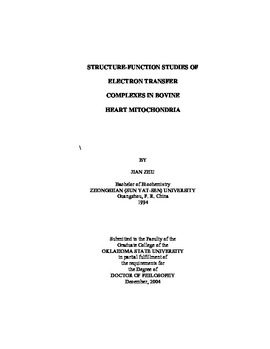| dc.contributor.advisor | Yu, Chang-An | |
| dc.contributor.author | Zhu, Jian | |
| dc.date.accessioned | 2013-12-10T18:05:24Z | |
| dc.date.available | 2013-12-10T18:05:24Z | |
| dc.date.issued | 2004-12 | |
| dc.identifier.uri | https://hdl.handle.net/11244/7829 | |
| dc.description.abstract | Various complexes within the bovine heart mitochondrial electron transfer chain were studied. The QPs1 subunit of Succinate: Ubiquinone Reductase was over expressed in Escherichia coli DH5alpha cells as a glutathione S-transferase fusion protein (GST-QPs1) using the expression vector, pGEX/QPs1. Recombinant QPs1 contains little cytochrome b560 heme. However, addition of hemin chloride reconstitutes the spectral characteristics of cytochrome b560. Reconstituted cytochrome b560 in recombinant QPs1 shows a EPR signal at g=2.91. Histidine residues at positions 98 and 120 are responsible for the heme ligation because the H98D or H120D-reconstituted QPs1 fail to restore cytochrome b560 upon addition of hemin chloride. | |
| dc.description.abstract | A purification procedure for NADH dehydrogenase of NADH:Ubiquinone Reductase was developed. This procedure involves acid extraction in the presence of organic solvent followed by ammonium sulfate fractionation, and DEAE column chromatography. Purified NADH dehydrogenase contains 3 protein subunits with apparent molecular weight of 51, 24, and 10 kD. It catalyzes oxidation of NADH by artificial electron acceptor, ferricyanide, with specific activity of 471 micromol Fe(CN)6^3- reduced/min/mg protein. The purified NADH dehydrogenase contains one FMN, five irons, and two EPR detectable iron sulfur clusters, one [4Fe-4S] and one [2Fe-2S]. Preliminary results of crystallization have been discussed. | |
| dc.description.abstract | Using ultra-fast microfluidic mixer and freeze-quenching device, coupled with EPR, the pre-steady state kinetic of ISP reduction by ubiquinol was determined. The complex was mixed with reduced Q0C10Br (QH2) to a final concentration of 50 microM of cytochrome c1, and 333 microM of QH2 in the ultrafast microfluidic mixer and freeze-quenching at various time points, ranging from 100 micros to 5 ms. The first phase reduction of ISP starts between 100 to 200 micros with t1/2 of 250 micros. A similar reduction kinetic is also observed for cytochrome bL with t1/2 micros of 350 micros indicating an almost simultaneously reduction of both ISP and bL. Possible detection of semiquinone radical at Qo site is also discussed. | |
| dc.format | application/pdf | |
| dc.language | en_US | |
| dc.rights | Copyright is held by the author who has granted the Oklahoma State University Library the non-exclusive right to share this material in its institutional repository. Contact Digital Library Services at lib-dls@okstate.edu or 405-744-9161 for the permission policy on the use, reproduction or distribution of this material. | |
| dc.title | Structure-function studies of electron transfer complexes in bovine heart mitochondria | |
| dc.contributor.committeeMember | Yu, Linda | |
| dc.contributor.committeeMember | Spivey, H. Olin | |
| dc.contributor.committeeMember | Melcher, Ulrich | |
| dc.contributor.committeeMember | Burnap, Robert Lord | |
| osu.filename | Zhu_okstate_0664D_1206.pdf | |
| osu.accesstype | Open Access | |
| dc.type.genre | Dissertation | |
| dc.type.material | Text | |
| dc.subject.keywords | electron transfer | |
| dc.subject.keywords | heart | |
| dc.subject.keywords | mitochondria | |
| dc.subject.keywords | qps | |
| thesis.degree.discipline | Biochemistry and Molecular Biology | |
| thesis.degree.grantor | Oklahoma State University | |
